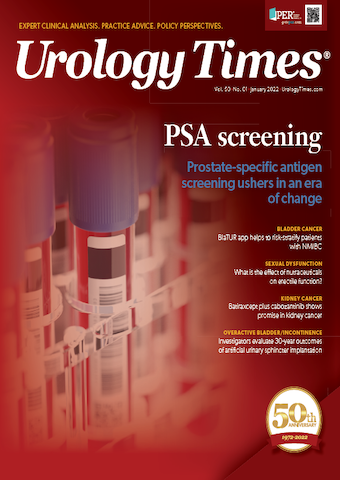Publication
Article
Urology Times Journal
Olaparib plus high-dose testosterone shows promise in prostate cancer
Author(s):
Bipolar androgen therapy (BAT) is a promising treatment for patients with metastatic castration-resistant prostate cancer (mCRPC). As an under-investigated treatment, investigators continue to experiment with this testosterone therapy to find the most efficacious ways to implement it and in what settings to do so safely.
Michael Schweizer, MD

In a recent study presented at the 2021 European Society for Medical Oncology Annual Meeting,¹ Michael Schweizer, MD, and co-authors examine the efficacy and safety of using BAT with PARP inhibitor olaparib (Lynparza) to treat patients with mCRPC. Schweizer is an associate professor in the division of medical oncology at the University of Washington and an associate professor in the clinical research division at the Fred Hutchinson Cancer Research Center, Seattle, Washington.
Could you discuss the background for this study?
I've been involved in a series of studies so far, both preclinical and clinical trials, that have looked at developing high doses of testosterone as a treatment for prostate cancer. This paradoxical approach is really based on a lot of work that came well before my time, showing that in certain prostate cancer models, high doses of androgens can lead to prostate cancer cell death. A number of different mechanisms have been proposed explaining why this might be the case. One of them was that high-dose testosterone can actually lead to the induction of double strand DNA damage. And so, that formed the basis for this clinical trial where we wanted to see if combining high doses of testosterone, along with the PARP inhibitor olaparib, would lead to better therapeutic outcomes by enhancing DNA damage. In our prior studies, we've shown that about a third of patients have a favorable response to high-dose testosterone when it's used in the castrate-resistant setting. We were looking to improve upon that with this clinical trial.
What were some of the notable findings? Were any of them surprising to you and your co-authors?
I think we were pleasantly surprised that this combo appeared to have really good efficacy, at least based on this relatively small 30-patient study. Overall, we saw 14 out of 30 patients had a favorable response in terms of their PSA falling at least 50% or more, which is, in some ways, surprising given the fact that we're giving these men testosterone, which you'd expect should cause the PSA to rise, if anything.
The other thing that was interesting to us was that, while this study was designed to evaluate efficacy in all comers, we saw similar outcomes in those with vs. without alterations in DNA damage repair genes. We mandated that half of the patients enrolled had a mutation in a gene involved in homologous recombination repair—one of the genes that would qualify someone for standard-of-care olaparib—and we found similar efficacy in the 15 patients who had a mutation in an HRR gene compared to those who did not have one of these mutations. So, there really didn't appear to be any enrichment in terms of clinical activity in those who would have qualified for olaparib monotherapy. That was surprising to us because we expected that responses would be higher in men with an HRR mutation since olaparib clearly has activity in this population.
What is the take-home message for the practicing urologist?
While this small study won’t change standard of care, I do think it appears very promising. Additional studies are justified and if positive, these could establish BAT plus olaparib as a standard treatment option for patients.
Is there anything else you feel our audience should know about the findings?
Overall, this combination was well tolerated and the patients did well clinically. This treatment approach is something we’re looking to test in larger follow up studies, which will hopefully pave the way towards this becoming a standard of care at some point in the future.
Reference
1. Schweizer MT, Gulati R, Yesefeski T, et al. Bipolar androgen therapy (BAT) plus olaparib in men with metastatic castration-resistant prostate cancer (mCRPC). Paper presented at: 2021 European Society for Medical Oncology Annual Meeting; September 16-21, 2021; virtual. Abstract 592P.






